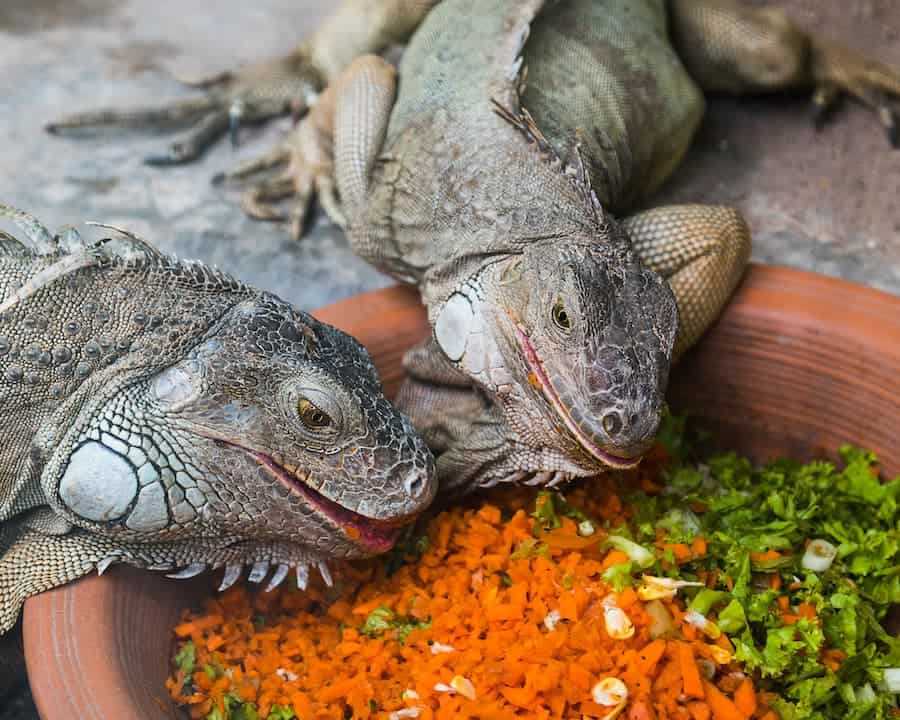Although iguanas are relatively small compared to many other animals, they can survive an impressive amount of time without eating. The exact time will vary with each iguana, as size, age, and state of health are all determining factors.
Generally speaking, a healthy adult iguana can survive for roughly one month without food, a hatchling only for 12-18 hours, and a juvenile for up to a week. Except for breeding season, loss of appetite is almost always a positive indicator that the iguana is suffering from a medical condition.
Don’t wait until your iguana is too far gone to take action. You can save your little green friend if you take the appropriate steps, which I’ll be happy to share with you in this post.
How Long Can Iguanas Survive Without Eating Food?
If your iguana is a healthy adult, you can expect it to live as long as one month (sometimes longer) without any food whatsoever. However, also expect severe weight loss, changes in behavior such as aggression, and the possibility of additional complications.
If cold temperature is the reason for a lack of appetite, your iguana may go into a state called brumation, which is a semi-type of hibernation where its metabolism slows down to conserve energy, usually resulting in a sleep-like trance.
However, green iguanas should only undergo brumation in a state of emergency. Do not expose your iguana to cold temperatures for extended periods, as death can occur.
Click the link to read a post I wrote about brumation and hibernation regarding iguanas.
How Long Can Wild Iguanas Live Without Food?
Wild iguanas can survive approximately one month without food, just like captive iguanas. However, medical conditions and/or physical injuries may reduce that time.
Furthermore, like their captive counterparts, wild iguanas will inevitably suffer from severe weight loss, behavior change, or additional health complications when fasting for prolonged periods.
How Long Can Baby Iguanas Go Without Food?
Like most species, a hatchling or juvenile animal will not have the same strength and caloric reserves as a full-grown adult. Therefore, a younger iguana won’t survive as long as an adult when prevented from eating.
An iguana that has just hatched or is as old as a few months is considered a hatchling. They usually range up to 2.75 inches snout-vent length (SVL). I was unable to find scientific research stating how long hatchlings can go without food, but it’s believed the duration is 12-18 hours, and up to a week for a juvenile.
Just like with adults, expect severe weight loss and complications should your hatchling or juvenile lack access to food for such a long time period.
How Often Do Iguanas Eat
Id like to strongly recommend that just because your iguana can go without eating for extended periods, doesn’t mean it should.
There is a popular misconception among iguana enthusiasts that feeding adult iguanas should only occur every two to three days. However, this couldn’t be further from the truth.
According to iguana expert James Hatfield in his book, “Green Iguana The Ultimate Owner’s Manual,” you should feed your iguana on a daily basis, regardless of age.
In fact, hatchlings should be fed two to three times a day, as they require a plethora of calories and nutrients.
Unlike cats or dogs, iguanas will self-regulate when it comes to eating. Hence, there is no need to restrict food from your iguana unless it’s a snack or food that cannot be frequently fed.
How Much Food Does An Iguana Eat Per Day?
Every iguana will require different amounts of food depending on its size, age, health condition, and time of the year. Additionally, breeding season is known to affect how much iguanas eat.
However, James Hatfield once again provides an amazing estimate of how much you can expect your iguana to eat based on its size.
The bulleted information below represents roughly how much you should feed your iguana per day. SVL represents the length from the iguana’s snout to its vent, vent being the cloaca area where waste is released.
- 5 in SVL: 2-4 tablespoons
- 7.5 in SVL: 3-6 tablespoons
- 8 in SVL: 5-8 tablespoons
- 12 in SVL: 2-3 cups
- 13 in SVL: 2-3 cups
Why Might An Iguana Stop Eating?
Iguanas may stop eating for a wide variety of reasons, as loss of appetite is usually the first symptom to manifest after a medical condition.
As a matter of fact, there are so many reasons why an iguana might stop eating that I wrote a whole post about it. If you’re worried (and rightfully so), check out my post, Reasons Why Your Iguana Is Not Eating, to not only identify the culprit but to also learn how to fix the issue.
However, for a short summary of the reasons iguanas may stop eating, check out the list below:
- Breeding
- Disease and/or parasites
- Injury
- Cold temperature
- Insufficient lighting (including cloudy days)
- Habitat change
- Shy eating in front of animals or people
- Stress from cage mate, other pets, or people
As you can tell, most of the reasons listed above can be easily rectified. If you suspect your iguana may have gotten sick, infected with parasites, injured, or is extremely weak, consult a herpetologist (reptile vet) right away.
However, stress can be induced via a plethora of sources. Hence, read this post I wrote regarding stress in iguanas to help you identify the true culprit.
Assuming your iguana has sufficient strength and mobility, you may be able to address the problem on your own.
What To Do If My Iguana Stops Eating?
Once again, if your iguana stops eating, and you suspect the problem is internal (disease, trauma, parasites), immediately take your scaly pet to the vet.
However, if you believe the culprit is something easily rectifiable, such as temperature, lighting, or stress, address each issue respectively first and foremost. Then, call a vet and ask whether you should resort to force-feeding your iguana.
For the most part, force-feeding should only be performed after consulting a vet and receiving their thumbs up, as force-feeding your iguana while failing to address a disease or parasite can still result in negative consequences.
According to Hatfield, there are three types of “force-feedings,” which you can attempt.
The first simply involves placing a bowl of food in front of your iguana to entice it to eat. Make sure the food has been finely chopped to facilitate swallowing.
If that doesn’t work, move on to the second type of force-feeding. Take a leaf of kale and roll it up like a burrito. Gently open your iguana’s mouth and insert the leaf inside.
A word of caution! Placing your fingers anywhere near an iguana’s mouth can get you bitten. Hence, a really great tip for opening a lizard’s mouth is to use a credit card. It may spare you a trip to the doctor. Gently insert the flat card in its mouth and rotate it to carefully pry open its mouth.
If you don’t want to use a credit card, open the iguana’s mouth by slowly and gently pulling down on its dewlap, towards the side of its chin.
If neither force feeding strategies work, you’ll have to resort to the third, which involves the following process:
- Blend your iguana’s food (add water if necessary to facilitate swallowing)
- Add the blended food to a syringe that does NOT have a needle
- Insert the NON-NEEDLE syringe into the iguana’s mouth and slowly dispense the food
Make sure to allow enough time for your iguana to swallow. Do not dispense the food contained in the syringe into the iguana’s mouth all at once. Additionally, talk to your vet regarding what supplements and vitamins you should add to the syringe solution.
If done correctly and consistently, force-feeding can very easily save your pet’s life.
How Long Can Iguanas Survive Without Water?
Although iguanas mostly hydrate from the water contained in foods, you should nevertheless have additional water in their enclosure. This concept is even more crucial if you feed your iguana dry processed food, as it lacks a lot of the moisture which would normally be absorbed via plants.
Assuming the iguana does not have access to food and water, a fully grown iguana can probably survive without water for a few days, while a hatchling only a few hours.
According to James Hatfield, iguanas drink by lapping, sipping, and deep sucking. However, they can also learn to drink out of bottles like mice and hamsters.
My iguana loved drinking water as I humidified his enclosure with a spray bottle. Regardless of how your iguana likes to drink, however, always provide them with access to water in their cage, and be sure to replace their drinking water on a daily basis (assuming it’s not in a bottle).
Another fact to keep in mind is the increase necessity of water consumption while an iguana is either sick or on medication.

